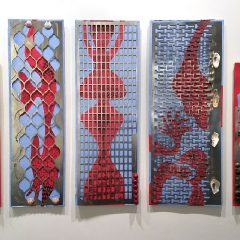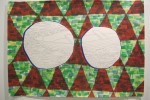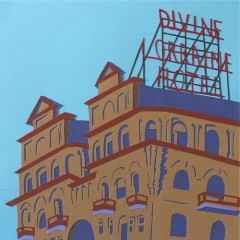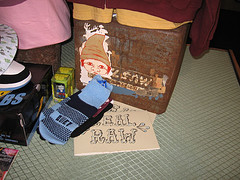
The can is a piece of art by Jason Fritzsche. Left over from an art exhibit at Minnow, it’s now used in a display of other goods.
“You have to go to Jinxed,” said Artblog correspondent Andrea Kirsh. So we went there and to Minnow, Saturday, two South Street area emporia that specialize in the hand-crafted side of skateboard culture.
How much was handcrafted? Oh, tons of it. And between the two stores, I felt like I had gone to an art show.
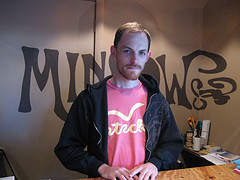
Metal
The highlight of the day, however, was something said by Metal, the owner of Minnow, at 700 S. 6th St. Metal is a University of the Arts graduate who sometimes makes his own work, but mostly he’s got this store, which is more of a mission than a business. The mission is to bring this local art work to the marketplace. Meanwhile, he needs to work an outside job to make ends meet.
Comparing New York artists to Philadelphia artists he said:
“Philadelphia’s just such a humble place. People here aren’t trying to be somebody. They are just trying to be themself.”
I think that pretty much sums it up. In a way, it makes me think that in the long term, for all the razzle-dazzle of the New York art world, what’s going on in Philadelphia really matters.
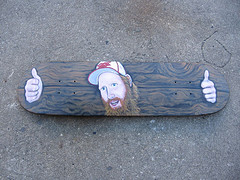
A skateboard deck by Mike Stein is a portrait of Philadelphia artist Thom Lessner, at Minnow
Metal has closed Minnow to make way for art exhibits inside, during his slow season. But even when the store is open, there’s plenty to look at–unusual skateboard decks, bits of art, hand-screened t’s and pillows, even homemade (campaign style pin-on buttons).
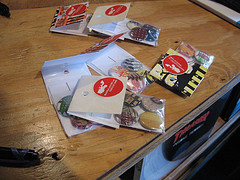
Mark Price’s hand-printed buttons
While I was in Minnow, I kept feeling like local artist Mark Price and Bay-area artist Jeremy Fish were following me around. Price, whose work Roberta and I first admired on the street in Old City, made some campaign-style pin-on buttons as well as a hand-screened skateboard deck. Andrea invested in some buttons. As for Fish, who showed at Space 1026 last year, a print of his hung near the register. And on the post-card pile-up near the door, Fish had a card advertising his current two-man show with Scott Musgrove at Lineage Gallery.
What’s funny to me about these two is they couldn’t be more unlike in their work, yet they both still fit in skateboard artland. Price is dark and veers into abstraction. Fish’s work is illustrational and cheerful, even when it contains skulls.
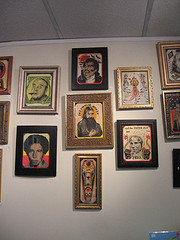
portraits by Drew Rash. I especially enjoyed Rasputin (middle).
When we got to Jinxed at 620 S. 4th St., we found the work of two artists–Drew Rash and Cosmo–hanging on the walls. Jinxed is a gallery that thinks it’s a clothing store. Judith Schaechter’s new book is there, hot off the presses, and you can look through it as well as buy it. In fact, there’s a whole library of hip art books, many of them hand made, that you can browse while sitting on the little sofa across from the bookshelves. Of course you can buy them, too.
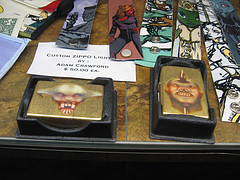
Zippo lighters hand-painted by Adam Crawford
The hand-painted goods ran the gamut, from Zippo lighters to recycled, painted purses.
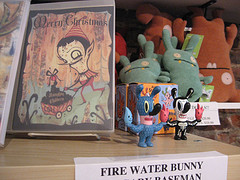
Cartoonist Gary Baseman’s Fire Water Bunnies reminded us of CerealArt multiples, but Baseman’s are in a price range a young skateboarder can afford.
Both shops had little figures–the low-priced versions of the sort of things CerealArt makes and sells by big-name artists in limited editions. Actually, cartoon artist Gary Baseman is a big-name cartoon artist, but he’s not part of the art mafia, so his toys-for-grown-boys are less expensive and made in larger runs.
Andrea, who is an art historian and curator, reminded me that the Greek vases that we all drool over were in fact popular culture in their day.
At what point things become commercial pop culture and at what point they become art–as defined by the art world–is unclear, but Libby and Roberta have long declared all of them art. They will remain art so long as they tell something significant about the culture that they represent. If that’s the case, they will become marketable in the larger art market (the Baseman link is to an art gallery). If not, like most art work, they’ll get lost in time.
I was reading an essay by Philadelphia Museum of Art contemporary art Curator Carlos Basualdo in What Makes a Great Exhibition?, a new book from the Philadelphia Exhibition Initiative’s Questions of Practice series. In a somewhat different context, he was talking about the relationship of what’s in the museum to the art market, and how galleries and museums deliver a stamp of approval that the art market then uses for marketing.
At the moment, the commerce in the skateboard land is a mix of things embraced by official galleries and museums and things on the periphery. At some point, the periphery becomes the center, some of the time. So you might want to check it out.
For more images, go to my Skateboard land flickr set.



